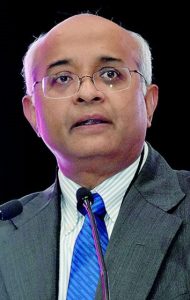“Five years from now no new Internal Combustion (IC) engine two-wheelers with liquid fuel will be sold in this country.”
– Vellayan Subbiah, Chairman, Cholamandalam Investment & Finance & MD-TII Ltd.
“Electric is the only automotive category out there.We are in the midst of an exponential growth… The petrol vehicle getting substituted by an EV is going to create demand like we have never seen.”
– Tarun Mehta, Co-Founder & CEO, Ather Energy.
“Large auto companies are carving out separate, nimble entities for EVs which would operate like start-ups backed by the corporation’s strength of finance and experience. Almost 50 per cent of the ride Indians will take in 2030 will be through shared mobility. Hence the focus on electric vehicles for mass mobility.”
– Mahesh Babu, CEO, Switch Mobility (Hinduja Group).
There was palpable enthusiasm and confidence on the part of the three young executives participating in a webinar on electric vehicles in India’s future moderated by that expert on mobility, Dr V Sumantran (VS), presented by the Chennai International Centre. Excerpts from the discussions:
The change is dramatic, but enthusiasm was infectious. EV is an answer for the environment conscious. The entire EV ecosystem will be a part of the larger energy ecosystem. The EV transformation will be closely linked to the basket of energy sources of the grid.
EVs darlings of investors

Legacy players are all bracing up for the fight. It will be an interesting dynamic in the market place among new start-ups, disruptors and legacy players. This dynamic is good for consumers and good for a vibrant economy.
A transformation of this nature will face challenges like marking large investments on infrastructure with easy facilities to charge vehicles. We will also be creating a monster by unleashing a large number of EV batteries but unprepared to deal with end-of-life issues of recycling and reclaiming expensive materials and disposing hazardous chemicals. The industry will also have to cope with obsolescence much faster than the auto industry had to deal with in the past.
Recycling is receiving some attention but needs more; because its neglect can create an environmental tragedy.
CHINA’S Excellence as global EV leader…
There are global trade implications: China focused on EVs to leapfrog the west to emerge global leaders in this business. In the process they have created a sense of fear on most global nations whether the future of the auto industry and supply chain will be China-dominated.
The auto industry and its components are a very large fraction of any industrial economy. We see a number of initiatives like Make in India, PLI supports and incentives, subsidies.. to battery cell manufacture. There are also generous subsidies and incentives to EV customers.
There is palpable fear amongst policy makers and some consumers that this migration to EV will end up with a massive dependence on China. It’s time for scaling up capabilities and investments particularly at the time when China has peaked its investments and built massive capacities.
Demand like never seen before – Tarun mehta
The biggest transformation is seen in the customer, from being mildly curious now certain over purchasing his next vehicles only electric…
The petrol vehicle is getting substituted by an EV and the demand is like we’ve never seen in the world before. Electric is the only automotive category out there.
Kinetic Honda had hugely and profoundly impacted the societies, notably it offered easy mobility to women, to half the population!
EVs will have an equally powerful impact because of the environmental concerns. There is an existing customer segment and a clear need.
The average customer seems to think he drives 1000 km a month and spends Rs 3000 a month for petrol! Actually it may be 400 km per month. The fact is that petrol has breached the Rs 100 rupees/litre psychological barrier, especially in the urban areas and petrol prices do not seem to come down.
Over the last 20 years our two-wheeler industry has done a lot of cost optimisation. Honda Activa launched at around 18-19 years ago, was then priced Rs 50,000; the price has gone to Rs 80,000- Rs 85,000 now. Still it has not kept in pace with inflation.
More purchasing power, but less options

Thirty per cent of the urban customers are now buying a scooter for Rs 1 lakh – Rs 1.25 lakh. Customers are willing to pay more just to buy something new for freshness sake. Industry hasn’t built new, better products for a while and electric just breathes fresh air.
No consumer is buying what the country needs. The country needs you to buy small, tiny cars that are all electric. But the consumer wants to buy an XUV 500 or a Toyota Innova!
Needed: operational efficiency…
OEMs have to be good at supply chain management and product planning. Most supply chains struggle because they don’t understand the customer needs in an EV product. We are still in the IC engine world of the 1920s and 1930s. Operational efficiency, more than product innovation, is needed.
We still import all from China to build an EV. This is wrong. It should be a global supply chain for an EV – like chips from Taiwan, displays from Singapore or Malaysia… Over the next five years things may improve and we would have moved far away from most imports for EVs from China.
We need to get more chargers before we sell vehicles and figure out ways to get chargers in every parking location that will encourage more people to buy EVs.
Most people go for replacement of EV batteries at 60-70 per cent of its life when several months of healthy usage is still left in it. There is an urgent need for recycling EV batteries.
Shared mobility will account for half – Mahesh babu
When looking for something related to technology and futuristic, EV emerged as a perfect product.
If the three important legs – policy making by the government, industry participation and consumers come together, economic growth is going to accelerate. The government wants to promote electric mobility. There is need to reduce oil import, reduce pollution and India has to become atma nirbhar.

India is urbanising fast. We’ll have to bring individual owners of vehicles to public transport -metros, buses and last mile connectivity vehicles. A study says that almost 50 per cent of the rides Indians will take in 2030 will be shared mobility. This is going to throw up new business models. That’s what we are looking at.
We need EVs for personal and commercial uses. Purchase of an EV for personal use will be more of lifestyle and emotional, to showcase customers’ environmental concerns! Their number is growing.
EV is a perfect fit for commercial use and earnings. For example, a woman three-wheeler owner, also working as a domestic help, can double her income. It can be a big societal shift. The commercial vehicle segment should leverage the lower operating cost of an EV and help upgrade people’s stature making them entrepreneurs.
Few years ago the suppliers in Tier I cities would not even entertain us. That led most OEMs to develop VW motors, battery packs… on their own technologies.
Now more investments are happening at the suppliers’ end with PLI and other incentives to manufacture motors, motor controllers, power electronics, battery packs… This is healthy and will reduce costs and increases sale of EVs.
Eventually the supply chain will become global. We don’t have natural resources in one country for producing several parts. Thus the focus is on value addition and new technology.
Why e-bicycles are left out? – VELLAYAN SUBBIAH
Cholamandalam is looking FOR funding opportunity and TII for supplies to the auto industry. Almost 70 per cent of TII’s revenue was coming from the auto industry.
Some of our businesses in the traditional automobile segment are going to become obsolete in the emerging electric world. It became imperative for us to act and not to wait. We had to decide what it should be into two-wheelers, three-wheelers or buses?

EVs are productive and consumptive. But a lot of development is needed. With the right policies of the government a massive ecosystem is being developed.
Today the quality of batteries, motors, controllers… for EVs is not on par with China’s. So, Chinese dependence would be initially there. Once volumes pick up it’ll go away.
I am a bit peeved that e-bicycles are left out. We sell an unsubsidised e-bicycle for Rs 20,000, significantly cheaper than electric two-wheelers. It is manoeuvrable, like other two-wheelers. If the government offers subsidies for e-bicycles, it’ll really make a difference. It’ll cut down the number of electric two-wheelers sold at much higher prices.
I feel disruptors are going to be at an advantageous position through funding of start-ups in the EV segment.
